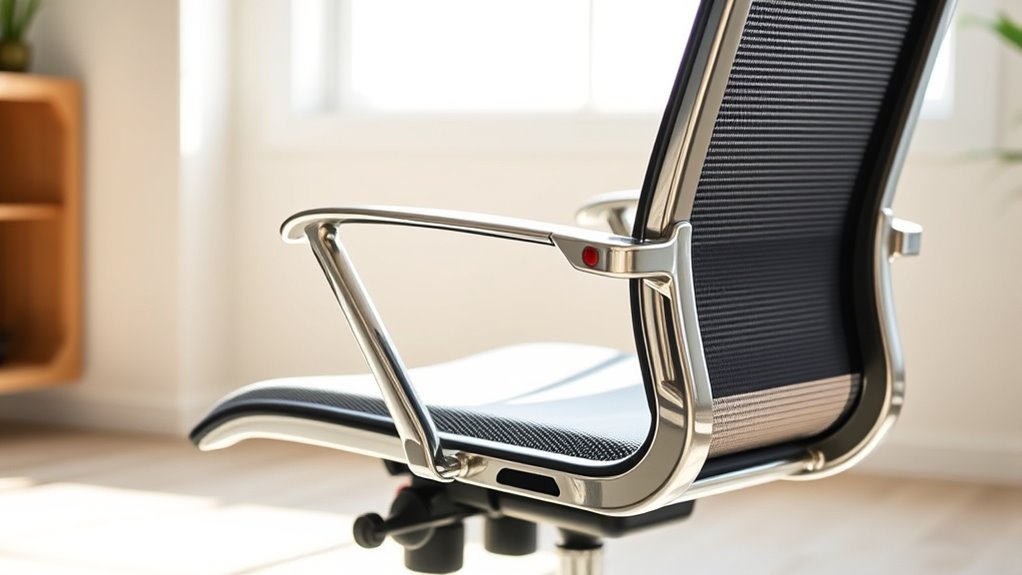The key feature that can truly save your back is adjustable lumbar support. It helps maintain proper spinal alignment by filling the lower back’s natural curve, reducing pressure and preventing slouching. Coupled with adjustable seat height, depth, and tilt mechanisms, it ensures you stay comfortable and supported all day. If you want to improve your chair’s ergonomic benefits, keep exploring how these features function together to protect your back effectively.
Key Takeaways
- Lumbar support maintains spinal alignment, reducing pressure and preventing slouching for healthier posture.
- Adjustable seat height ensures feet rest flat, promoting stability and proper ergonomic positioning.
- Proper armrest setup supports arms and shoulders, minimizing muscle strain during extended sitting.
- Tilt mechanisms allow recline customization, enhancing comfort and spinal health during long periods of use.
- Regular maintenance preserves ergonomic features, ensuring ongoing back support and overall chair safety.
Understanding Lumbar Support and Its Importance
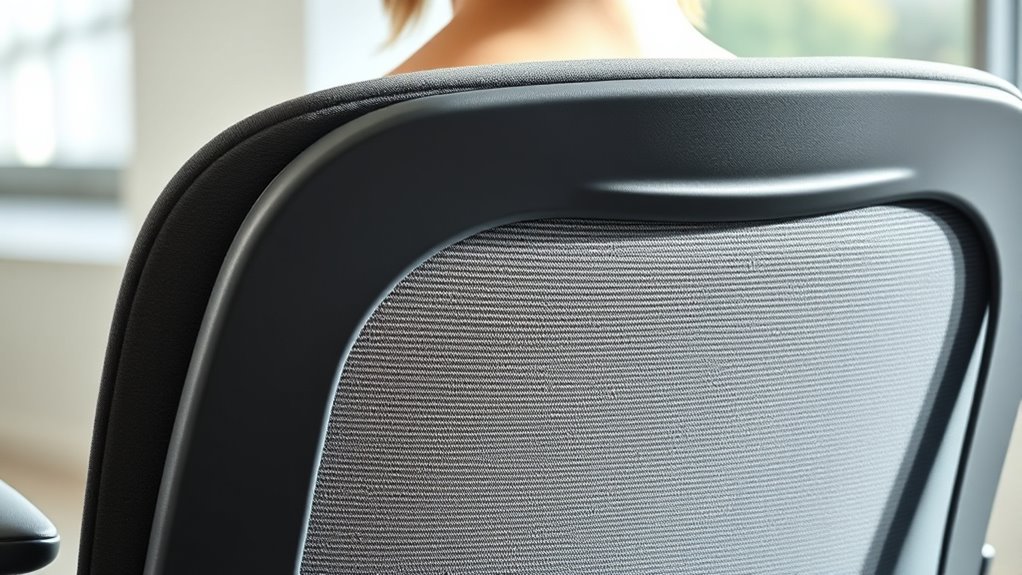
Have you ever noticed how discomfort in your lower back can quickly ruin your day? That’s where lumbar support makes a real difference. Proper lumbar support helps maintain your spinal alignment by filling the natural curve in your lower back. When your chair provides adequate lumbar support, it prevents you from slouching or leaning forward, which can cause strain and pain. You might not realize it, but many chairs lack this feature, leading to poor posture over time. By choosing a chair with good lumbar support, you actively support your lower spine, reducing pressure and promoting healthier posture. This simple feature can considerably decrease the risk of chronic back issues and keep you comfortable during long hours of sitting. Recognizing the importance of suitable ergonomic features can further enhance your overall back health and sitting experience.
How Adjustable Seat Heights Enhance Comfort
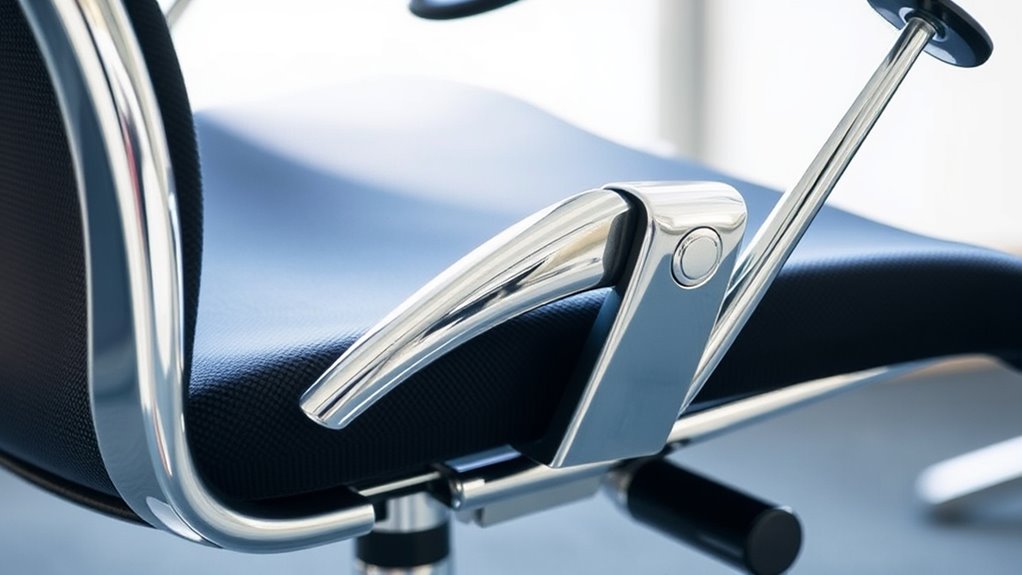
When you adjust your seat height properly, your feet rest flat on the floor, providing better stability. This helps reduce back strain by keeping your spine aligned naturally. Additionally, proper ergonomic positioning can prevent discomfort and promote better posture throughout the day. Ultimately, a simple adjustment can make a big difference in your comfort throughout the day.
Proper Feet Placement
Adjusting your seat height is key to guaranteeing proper feet placement, which directly affects your comfort and posture. When your chair is properly calibrated, your feet should rest flat on the floor with your knees at a 90-degree angle. This foot positioning helps distribute your weight evenly and reduces pressure on your lower back. If your chair is too high, your feet may dangle, causing discomfort and poor circulation. Conversely, if it’s too low, you might strain your hips or sit in an awkward position. Take time to fine-tune your seat height so that your feet are firmly supported, and your legs are comfortable. Proper chair calibration ensures your feet are correctly positioned, promoting better overall ergonomics and reducing fatigue during long hours of sitting. Ensuring your feet are properly supported can also help improve blood flow and prevent numbness.
Reduced Back Strain
Properly adjusting your seat height directly reduces back strain by ensuring your spine stays aligned and supported. When your chair is at the right height, your hips are level, and your back maintains its natural curve. This position helps prevent slouching and relieves pressure on your lower back. Additionally, an adjustable seat height allows you to optimize your workspace, such as aligning your keyboard layout for comfortable typing. It also lets you choose a chair with breathable material, promoting airflow and reducing discomfort during long hours. To maximize comfort, focus on: 1. Setting your seat height so your feet rest flat on the floor. 2. Ensuring your knees are roughly level with your hips. 3. Adjusting to maintain proper keyboard positioning and material breathability. Proper seat adjustment also contributes to maintaining good posture throughout extended periods of sitting.
The Role of Seat Depth Adjustment in Preventing Strain

Ensuring your seat depth is correctly adjusted plays a crucial role in preventing strain during prolonged sitting. Proper seat depth ensures your thighs are fully supported without pressing against the edge of the chair, which can cause discomfort and reduce circulation. When the seat is too deep, you may lean forward or slouch, increasing back and hip strain. Conversely, if it’s too shallow, you’ll lack proper thigh support, leading to muscle fatigue. Adjusting seat depth allows you to maintain an ergonomic posture, keeping your hips at a neutral position and reducing unnecessary pressure on your lower back. Additionally, ergonomic design features like adjustable seat depth are essential for achieving optimal comfort. This simple feature is essential for strain prevention, helping you sit comfortably and maintain focus without discomfort or fatigue setting in.
Benefits of Tilt Tension and Lock Mechanisms

Tilt tension and lock mechanisms give you greater control over your chair’s movement, allowing you to customize your sitting experience for maximum comfort. With these features, you can adjust the tilt tension to match your body weight, making reclining smooth and effortless. Lock mechanisms enable you to fix the chair in a preferred position, supporting your back during focused work. Benefits include:
- Enhanced comfort with personalized tilt settings that suit your posture.
- Reduced strain through proper support, especially when using breathable fabric for better airflow.
- Improved ergonomics when adjusting features like armrests, ensuring your arms stay supported at the right height during recline.
- Proper support and posture are essential for preventing discomfort and promoting overall spinal health during long sitting periods.
These mechanisms ensure your chair adapts to your needs, promoting better posture and preventing discomfort during long sitting periods.
The Significance of Armrest Adjustability
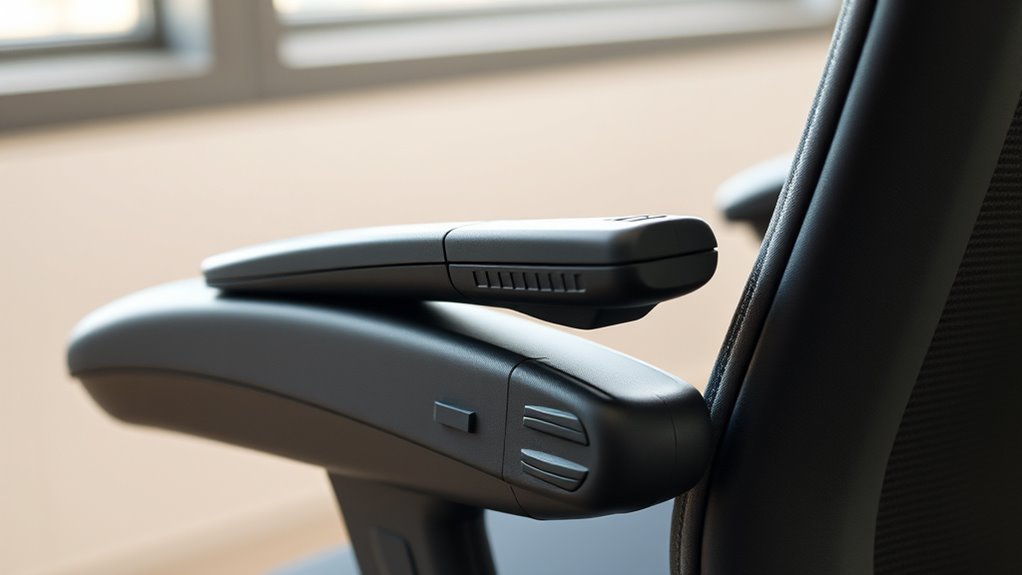
Adjustable armrests help you sit with better posture and prevent unnecessary shoulder tension. When you customize their height and position, you reduce strain and stay comfortable longer. Proper armrest adjustability is key to supporting your body during extended work sessions. Additionally, ergonomic designs that incorporate adjustable features can enhance overall comfort and reduce fatigue throughout the day.
Promotes Proper Posture
Because proper posture relies heavily on support, the adjustability of armrests plays a crucial role in maintaining spinal alignment. When armrests are adjustable, you can position them to support your arms comfortably, reducing strain on your shoulders and neck. This helps you sit upright naturally, promoting proper posture. Additionally, consider the chair material and aesthetic design, which influence comfort and style, ensuring your workspace feels inviting and supportive. To maximize benefits:
- Adjust armrests so your elbows are at a 90-degree angle.
- Ensure armrests support your forearms without pushing your shoulders up.
- Choose a chair with a sleek, ergonomic aesthetic design that complements your workspace.
- Incorporating automation technology in your workspace can help optimize ergonomic setups by providing customizable support features.
This combination encourages sustained good posture, preventing discomfort over long periods.
Reduces Shoulder Strain
Properly supporting your arms with adjustable armrests can considerably reduce shoulder strain. When your armrests are at the right height, your shoulders stay relaxed, preventing unnecessary tension. Without proper arm support, you may find yourself hunching or shrugging, which increases shoulder tension over time. Adjustable armrests allow you to position your arms comfortably, keeping your shoulders down and relaxed. This minimizes fatigue and reduces the risk of discomfort during long periods of sitting. By ensuring your arms are properly supported, you help maintain proper posture and prevent muscle strain. The right armrest setup encourages better ergonomics, making it easier to work comfortably and avoid the aches associated with sustained shoulder tension.
Features to Look for in an Ergonomic Office Chair
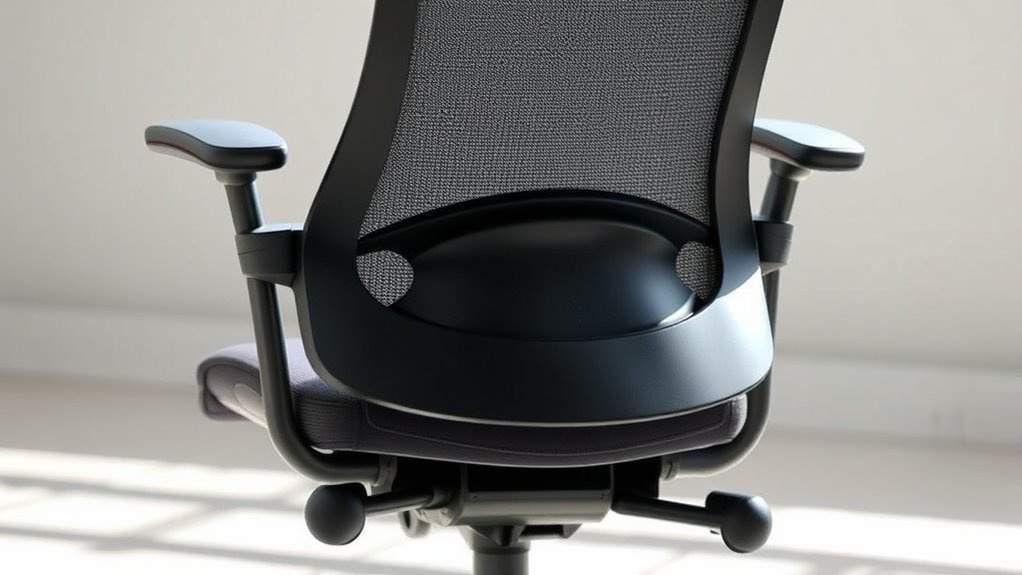
When choosing an ergonomic office chair, focusing on key features can make a significant difference in your comfort and support throughout the workday. First, look for durable materials that guarantee longevity and stability, especially in the seat and backrest. Second, prioritize aesthetic design to match your workspace and boost your motivation. Third, check for adjustability features like lumbar support, armrests, and seat height, which personalize comfort. Material durability assures the chair will withstand daily use, while an appealing design keeps your workspace visually pleasing. Additionally, selecting a chair with high-quality construction can ensure long-term reliability and support. Combining these elements ensures your chair not only supports your back effectively but also complements your environment, making long hours at your desk more manageable.
Common Mistakes When Setting Up Your Chair
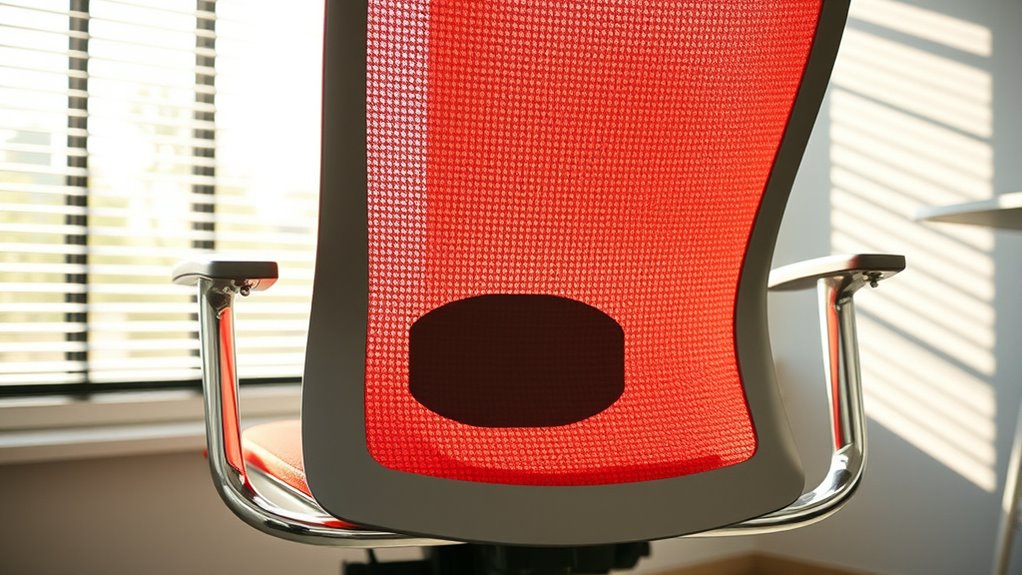
Many people make common mistakes when setting up their office chair, which can lead to discomfort and strain over time. One mistake is ignoring chair aesthetics; choosing a style that clashes with your workspace can decrease motivation. Another is overlooking material durability—selecting a chair with flimsy materials reduces longevity and support. Incorrect height adjustment causes poor posture, leading to back pain. Failing to adjust lumbar support or armrests can increase strain. Finally, neglecting to check the overall stability risks safety. Here’s a quick guide:
| Mistake | Impact | Fix |
|---|---|---|
| Ignoring chair aesthetics | Reduced workspace motivation | Choose a style matching your decor |
| Overlooking material durability | Shorter lifespan and support | Opt for high-quality, durable materials |
| Incorrect height adjustment | Poor posture and back pain | Adjust so feet are flat, knees at 90° |
| Not adjusting lumbar support | Increased lower back strain | Properly position lumbar support |
| Neglecting stability | Safety hazards | Ensure chair is stable and balanced |
Additionally, understanding the benefits of glycolic acid can help you select skincare products that maintain skin health and support your overall wellness.
Tips for Maintaining Your Chair’s Ergonomic Benefits
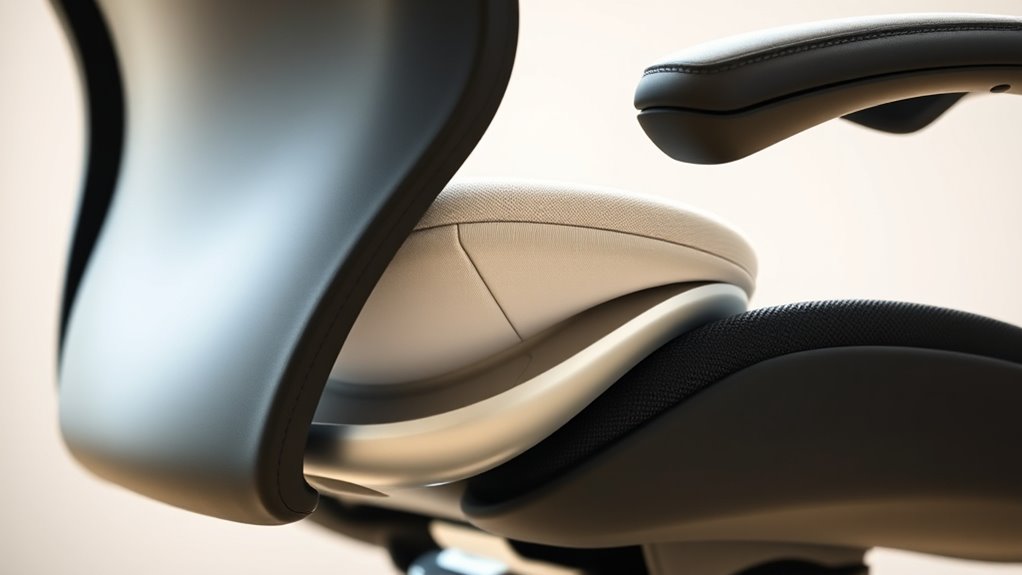
To keep your office chair providing ergonomic benefits, regular maintenance is essential. Proper care helps preserve the chair material and color options, ensuring lasting support. First, clean your chair regularly using a gentle cloth suited for its material—fabric, leather, or mesh—to prevent dust buildup. Second, check and tighten any loose screws or mechanisms to maintain stability and proper function. Third, inspect the chair’s features, like the lumbar support and adjustable parts, and ensure they move smoothly. If your chair has fabric or leather, consider using appropriate conditioners to keep the material supple and looking new. By following these tips, you’ll extend your chair’s ergonomic benefits, making sure it continues to support your back and match your workspace style.
Frequently Asked Questions
How Do I Know if My Chair Properly Supports My Lower Back?
You can tell if your chair properly supports your lower back by checking its lumbar support. Sit back and see if the support aligns with your natural lumbar curve, providing gentle pressure. During an ergonomic assessment, verify the support is adjustable and fits snugly without causing discomfort. Proper lumbar support reduces strain, so if you feel pain or slouching, your chair may need better support or adjustment.
Can Adjustable Features Reduce Long-Term Back Pain?
Think of your chair’s adjustable features as your personal back-up plan—ready to adapt to your needs. Yes, they can reduce long-term back pain by ensuring proper posture correction and maintaining lumbar support as you shift positions. When you customize your chair, you’re actively protecting your spine, just like a guardian angel, making discomfort less likely and comfort more consistent. Adjust, support, and feel the difference every day.
What Is the Best Way to Test a Chair’S Ergonomic Features Before Buying?
When testing a chair’s ergonomic features, sit in it and adjust to your height and posture. Confirm it’s comfortable and supports your back. Check for ergonomic certifications like ANSI or BIFMA, which verify quality standards. Also, consider the chair’s weight capacity to ensure it can support you safely. Test the tilt, lumbar support, and armrest adjustability to see if they meet your needs before making a decision.
How Often Should I Adjust My Chair During the Workday?
You should make frequent adjustments to your chair throughout the workday to maintain comfort and support. Aim to change your position every 30 minutes to prevent stiffness and promote good posture. Incorporate ergonomic routines like adjusting the seat height, lumbar support, and armrests regularly. This helps reduce strain and keeps you comfortable, ensuring your back stays healthy and you stay productive. Remember, consistent, mindful adjustments are key.
Are There Specific Fabrics or Materials Better for Back Health?
Like a gentle breeze on a summer day, breathable fabrics keep you comfortable. Opt for chairs with breathable fabrics or hypoallergenic materials to promote back health. These options allow airflow, reducing sweat and irritation, which helps maintain good posture and prevents discomfort over long hours. Choosing the right fabrics can make a noticeable difference in your overall comfort, keeping your back happy and supported throughout your workday.
Conclusion
Think of your chair as the foundation of your well-being at work. When you choose features like lumbar support and adjustable settings, you’re building a sturdy bridge between comfort and health. Neglecting these can be like ignoring cracks in your foundation—small issues that lead to bigger problems. Prioritize your chair’s ergonomic features, and you’ll create a safe haven where your back feels protected and your productivity soars, turning everyday sitting into a act of self-care.
